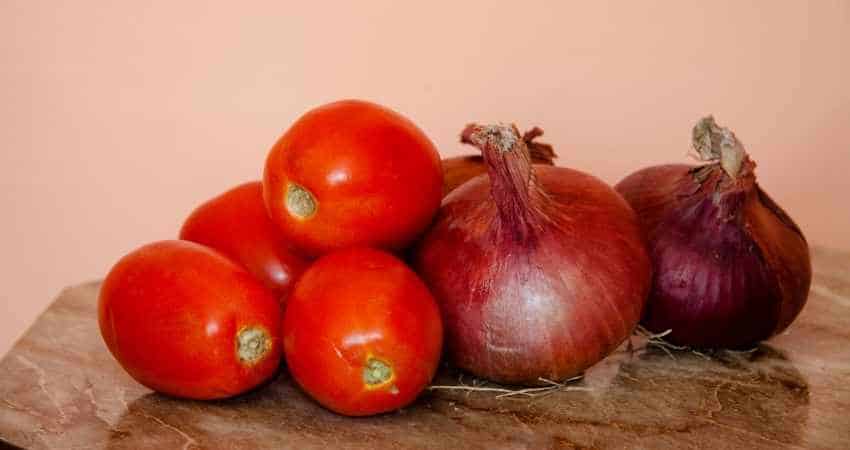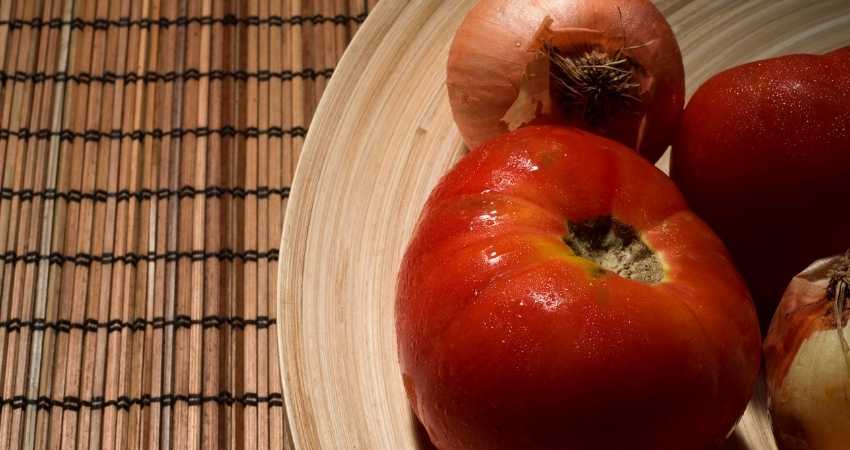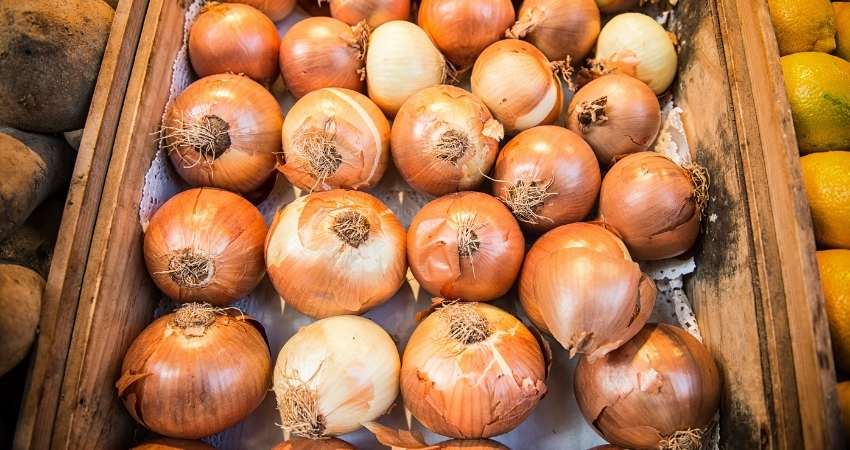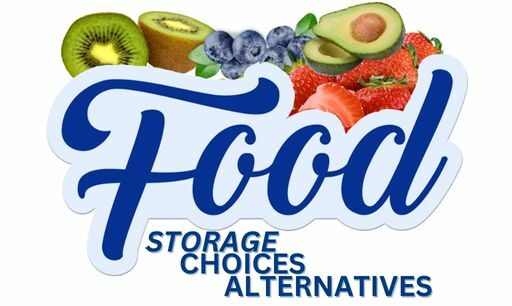Can You Store Tomatoes With Onions?
Two of the common fresh produce items are tomatoes and onions. Therefore, many people wonder if you could store them together.
Tomatoes and onions should be stored separately. While both are to be kept in a cool and dry place and should not be refrigerated, each has its own specific storage recommendations. Storing tomatoes and onions separately will ensure a longer shelf life and preserve their nutritional value longer.
As a Certified Health Coach this topic comes up a lot during my coaching sessions.Therefore, read on to find out the best way to store and keep tomatoes and onions fresh.
Disclaimer: Some links in this article are affiliate links which means I may earn a small commission at no extra cost to you. As an Amazon associate I earn from qualifying purchases.

Storing Tomatoes and Onions
The Washington Post shares that fruits and vegetables do not go well together and should not be stored next to each other in one container or drawer1. This is because many fruits produce ethylene gas, which serves as a ripening hormone and can speed up spoilage2.
To keep onions and other vegetables fresh longer, it’s best to separate them from fruits that produce ethylene. While nutritionists consider tomatoes as vegetables, they are technically fruits3.
Onions, on the other hand, are vegetables4. Therefore, considering these definitions, you may want to store your tomatoes and onions separately. Fruits that produce ethylene include the following:
- Tomatoes
- Pears
- Mangoes
- Apples
- Avocados
- Kiwi
- Apricots
- Ripe Bananas
- Plums
- Peaches
- Persimmons
- Papaya
- Passion Fruit
- Cantaloupe
Storing tomatoes and onions according to their preferred storage conditions will ensure a longer shelf life5. Not only that, but it will also ensure that their health benefits and their nutritional components are well-preserved and intact until you consume them.
You can juice tomatoes or onions for a popular healthy drink. If you’re looking for a good quality juicer, Breville has a nice variety and very stylish. You can check the current price on Amazon by clicking here, Breville Juicers, along with other affordable options.
The Best Way to Store Tomatoes
The Old Farmer’s Almanac recommends storing your tomatoes at cool room temperature without exposure to direct sunlight. If your tomatoes are green, you could place them in layers inside a shallow box, each layer separated by a piece of paper.
This method will ripen your tomatoes more quickly. The article also advises against refrigerating tomatoes if you want them to retain their freshly picked taste6.
It depends on what type they are. The Washington Post article cites tomato experts and “Epic Tomatoes” author Craig LeHoullier as saying this is the correct way to store tomatoes.
Side down on a rack. This is to help keep moisture from gathering around the stem and causing the fruit to spoil faster. While LeHoullier agrees with Cook’s Magazine’s recommendation in its Tomato Primer, there is inadequate evidence showing that it is the best storage method7.
They also wrote that as long as the tomatoes are fully ripe, keeping them inside the fridge for a few days will extend their shelf life but will not ruin their flavor. In addition, don’t store ripe tomatoes with other ethylene producing fruits. Keep them stored alone and not touching each other.
If you’re considering long-term storage, you can store the tomatoes in a freezer. You can place them in there whole or chopped up and store them in an airtight bag to preserve the flavor and freshness ((Wikihow: How to Store Tomatoes (Long Term) )).
Before using them in a recipe, always give them several hours out of the freezer to regain their flavor ((The Spruce Eats: How to Preserve Tomatoes)).

Why Proper Storage of Tomatoes Is Important
One food engineering review article explains that the processing and storage of tomatoes and tomato-based products have an effect on its lycopene content8. Proper storage and processing will help preserve this beneficial carotenoid until the fruit and its related products are consumed.
It further notes that heat, light, and oxygen are among the factors that significantly affect the main lycopene degradation reactions and that these reactions, in turn, affect the bioactivity and bioavailability of lycopene compounds.
The Best Way to Store Onions
According to The Old Farmer’s Almanac, onions should be stored in a cool, dry, and ventilated place, preferably in mesh bags for circulation. If a mesh bag is not available, you can place them in a bowl in your pantry or on the kitchen counter where you can easily reach them while cooking. You may cover this bowl with a bag, but you need to make sure there are ventilation holes.
Onions should not be placed in a refrigerator. The Washington Post explains that the humidity and the cold temperature would turn onions mushy ((The Washington Post: Ten fruits and vegetables you’re storing wrong)). Storing onions away from light also keeps them from becoming bitter.
The article even suggests using a pantyhose as an alternative storage system in the absence of a mesh bag. Put the onions inside the legs of the hose, making knots in between each one.
If there is one thing you should never store with your onions, it is potato. According to Reader’s Digest’s The Healthy, onions will cause potatoes to go bad9. A good storage companion for onions is garlic. You can store them together or near each other without the risk of ripening or spoiling.
Why Proper Storage of Onions Is Important
The National Onion Association, explains that onions need to be stored in a cool, dark, dry, and well-ventilated space like the pantry or cellar because they absorb moisture very easily10.
When temperatures or humidity get too high, the onions may begin to sprout or spoil. The best temperatures for onions to be able to maintain their original characteristics are at 40 to 50°F (4 to 10°C).
Lack of sunlight also lessens any significant change in humidity and temperature. Moreover, proper ventilation will keep the onions from molding and rotting. As such, avoid keeping them in plastic bags as they don’t have breathability.
Store-bought onions have been cured after they were harvested and, as such, have papery skin. The curing is done to remove excess moisture, which helps onions last longer.
Storing whole, unpeeled onions in the fridge exposes them to cold and humid conditions, and because they easily absorb moisture, they could quickly become mushy and could quickly spoil.
This same rule, however, does not apply to sliced, peeled, or diced onions. Once peeled, they can be stored in the refrigerator for up to two weeks, whereas sliced and diced ones will last for seven to 10 days inside11.

Additional Tips on Storing Tomatoes and Onions
If you did store your tomatoes in a fridge, remove them two to three hours prior to eating them. This ensures your tomato regains some of its flavor.
How often have you waited for a fruit, like an avocado, to ripen? Often, it seems it can take forever. To speed up the process, you can store an unripe avocado with other ethylene producing fruits listed above. However, keep your eyes on it because you don’t want them to over-ripen.
If you have any questions to ask me about this article don’t hesitate to comment below or email us. You can find an email on our contact page.
Read Next
Can You Store Blueberries and Strawberries Together?
Can You Store Cinnamon in the Fridge?
Can You Store Strawberries and Blackberries Together?
- The Washington Post: Ten fruits and vegetables you’re storing wrong [↩]
- IEEEXplore: Feature extraction for ethylene gas measurement for ripening fruits [↩]
- Britannica: Is a Tomato a Fruit or a Vegetable? [↩]
- Wikipedia: Onion [↩]
- ResearchGate: Extending the shelf life of a tomato and onion in Nigeria: A review [↩]
- The Old Farmer’s Almanac: How To Store Vegetables And Fruit [↩]
- Cook’s Illustrated: Tomato Primer [↩]
- Springer Link: Processing, Packaging, and Storage of Tomato Products: Influence on the Lycopene Content [↩]
- The Healthy: 12 Fresh Foods You Should Never Store Together [↩]
- National Onion Association: Best Tips for Storing Onions [↩]
- USDA: Onions, Bulb, Ready-To-Use [↩]
